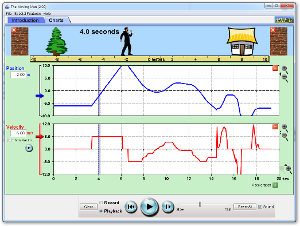Take a Logger Pro trial of the car as it travels down the ramp. Save the .cmbl file and upload to your Google Docs/share.
Autoscale the Logger Pro data and print off the graph. Mark an A point and the B point to show the start of the acceleration and a point near the bottom of the ramp. Print this graph.
Calculate/show the following:
- distance from A to B
- time elapsed
- v(i)
- v(f)
- a(ramp)
Now, determine a way (using your video) to find the a(deceleration) of the floor surface. One way is to open the video using Windows Live Movie Maker, which gives you a frame-by-frame analysis. Detail your method.
Answer the following questions INDIVIDUALLY.
a) what process did you use to decide on what type of a car to build?
b) what did you have to overcome to get the wheels to spin?
c) was your car able to travel a consistent distance? How do you know?
d) what would you do differently if you built the car again?
e) was the wheel design or the body design more critical. Explain.
f) how many data trials did you conduct? How confident are you that your video was a reliable representation of what your car could do?
If you were to draw a d-t graph for the entire interval of motion, what would it look like?



